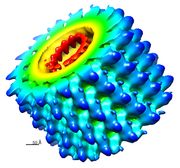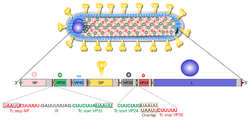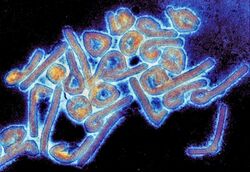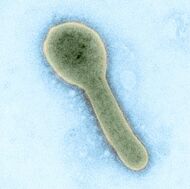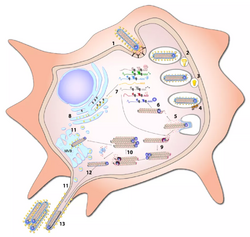Biology:Marburg virus
| Marburg virus | |
|---|---|
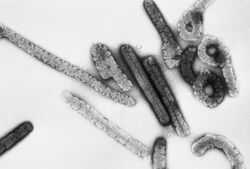
| |
| Transmission electron micrograph of Marburg virus | |
| Virus classification | |
| (unranked): | Virus |
| Realm: | Riboviria |
| Kingdom: | Orthornavirae |
| Phylum: | Negarnaviricota |
| Class: | Monjiviricetes |
| Order: | Mononegavirales |
| Family: | Filoviridae |
| Genus: | Marburgvirus |
| Species: | |
| Virus: | Marburg virus
|
Marburg virus (MARV) is a hemorrhagic fever virus of the Filoviridae family of viruses and a member of the species Marburg marburgvirus, genus Marburgvirus.[1] It causes Marburg virus disease in primates, a form of viral hemorrhagic fever.[2] The virus is considered to be extremely dangerous. The World Health Organization (WHO) rates it as a Risk Group 4 Pathogen (requiring biosafety level 4-equivalent containment).[3] In the United States, the National Institute of Allergy and Infectious Diseases ranks it as a Category A Priority Pathogen[4] and the Centers for Disease Control and Prevention lists it as a Category A Bioterrorism Agent.[5] It is also listed as a biological agent for export control by the Australia Group.[6]
The virus can be transmitted by exposure to one species of fruit bats or it can be transmitted between people via body fluids through unprotected sex and broken skin. The disease can cause haemorrhage, fever, and other symptoms similar to Ebola, which belongs to the same family of viruses. According to the WHO, there are no approved vaccines or antiviral treatment for Marburg, but early, professional treatment of symptoms like dehydration considerably increases survival chances.[7]
In 2009, expanded clinical trials of an Ebola and Marburg vaccine began in Kampala, Uganda.[8][9]
History
Discovery
Marburg virus was first described in 1967.[12] It was discovered that year during a set of outbreaks of Marburg virus disease in the German cities of Marburg and Frankfurt and the Yugoslav capital Belgrade. Laboratory workers were exposed to tissues of infected grivet monkeys (the African green monkey, Chlorocebus aethiops) at the Behringwerke, a major industrial plant in Marburg which was then part of Hoechst, and later part of CSL Behring. During the outbreaks, thirty-one people became infected and seven of them died.[13]
Nomenclature
The virus is one of two members of the species Marburg marburgvirus, which is included in the genus Marburgvirus, family Filoviridae, and order Mononegavirales. The name Marburg virus is derived from Marburg (the city in Hesse, Germany, where the virus was first discovered) and the taxonomic suffix virus.[1]
Marburg virus was first introduced under this name in 1967.[12] The virus name was changed to Lake Victoria marburgvirus in 2005, confusingly making the only difference in distinguishing between a Marburg virus organism and its species as a whole italicization, as in Lake Victoria marburgvirus.[14][15][16] Still, most scientific articles continued to use the name Marburg virus. Consequently, in 2010, the name Marburg virus was reinstated and the species name changed.[1]
Virology
Genome
Like all mononegaviruses, marburg virions contain non-infectious, linear nonsegmented, single-stranded RNA genomes of negative polarity that possess inverse-complementary 3' and 5' termini, do not possess a 5' cap, are not polyadenylated, and are not covalently linked to a protein.[17] Marburgvirus genomes are approximately 19 kbp long and contain seven genes in the order 3'-UTR-NP-VP35-VP40-GP-VP30-VP24-L-5'-UTR.[18]
Structure
Like all filoviruses, marburgvirions are filamentous particles that may appear in the shape of a shepherd's crook or in the shape of a "U" or a "6", and they may be coiled, toroid, or branched.[18] Marburgvirions are generally 80 nm in width, but vary somewhat in length. In general, the median particle length of marburgviruses ranges from 795 to 828 nm (in contrast to ebolavirions, whose median particle length was measured to be 974–1,086 nm), but particles as long as 14,000 nm have been detected in tissue culture.[19]
Marburgvirions consist of seven structural proteins. At the center is the helical ribonucleocapsid, which consists of the genomic RNA wrapped around a polymer of nucleoproteins (NP). Associated with the ribonucleoprotein is the RNA-dependent RNA polymerase (L) with the polymerase cofactor (VP35) and a transcription activator (VP30). The ribonucleoprotein is embedded in a matrix, formed by the major (VP40) and minor (VP24) matrix proteins. These particles are surrounded by a lipid membrane derived from the host cell membrane. The membrane anchors a glycoprotein (GP1,2) that projects 7 to 10 nm spikes away from its surface. While nearly identical to ebolavirions in structure, marburgvirions are antigenically distinct.[20]
Entry
Niemann–Pick C1 (NPC1) cholesterol transporter protein appears to be essential for infection with both Ebola and Marburg virus. Two independent studies reported in the same issue of Nature showed that Ebola virus cell entry and replication requires NPC1.[21][22] When cells from patients lacking NPC1 were exposed to Ebola virus in the laboratory, the cells survived and appeared immune to the virus, further indicating that Ebola relies on NPC1 to enter cells. This might imply that genetic mutations in the NPC1 gene in humans could make some people resistant to one of the deadliest known viruses affecting humans. The same studies described similar results with Marburg virus, showing that it also needs NPC1 to enter cells.[21][22] Furthermore, NPC1 was shown to be critical to filovirus entry because it mediates infection by binding directly to the viral envelope glycoprotein[22] and that the second lysosomal domain of NPC1 mediates this binding.[23]
In one of the original studies, a small molecule was shown to inhibit Ebola virus infection by preventing the virus glycoprotein from binding to NPC1.[22][24] In the other study, mice that were heterozygous for NPC1 were shown to be protected from lethal challenge with mouse-adapted Ebola virus.[21]
Replication
The Marburg virus life cycle begins with virion attachment to specific cell-surface receptors, followed by fusion of the virion envelope with cellular membranes and the concomitant release of the virus nucleocapsid into the cytosol.[citation needed]
The virus RdRp partially uncoats the nucleocapsid and transcribes the genes into positive-stranded mRNAs, which are then translated into structural and nonstructural proteins. Marburgvirus L binds to a single promoter located at the 3' end of the genome. Transcription either terminates after a gene or continues to the next gene downstream. This means that genes close to the 3' end of the genome are transcribed in the greatest abundance, whereas those toward the 5' end are least likely to be transcribed. The gene order is therefore a simple but effective form of transcriptional regulation.[25]
The most abundant protein produced is the nucleoprotein, whose concentration in the cell determines when L switches from gene transcription to genome replication. Replication results in full-length, positive-stranded antigenomes that are in turn transcribed into negative-stranded virus progeny genome copies. Newly synthesized structural proteins and genomes self-assemble and accumulate near the inside of the cell membrane. Virions bud off from the cell, gaining their envelopes from the cellular membrane they bud from. The mature progeny particles then infect other cells to repeat the cycle.[14]
Ecology
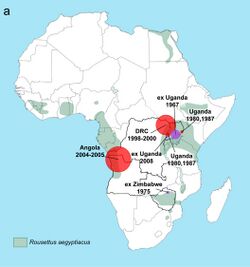
In 2009, the successful isolation of infectious MARV was reported from caught healthy Egyptian fruit bats (Rousettus aegyptiacus).[26] This isolation, together with the isolation of infectious RAVV,[26] strongly suggests that Old World fruit bats are involved in the natural maintenance of marburgviruses. Further studies are necessary to establish whether Egyptian rousettes are the actual hosts of MARV and RAVV or whether they get infected via contact with another animal and therefore serve only as intermediate hosts. In 2012 the first experimental infection study of Rousettus aegyptiacus with MARV provided further insight into the possible involvement of these bats in MARV ecology.[27]
Experimentally infected bats developed relatively low viremia lasting at least five days, but remained healthy and did not develop any notable gross pathology. The virus also replicated to high titers in major organs (liver and spleen), and organs that might possibly be involved in virus transmission (lung, intestine, reproductive organs, salivary gland, kidney, bladder, and mammary gland). The relatively long period of viremia noted in this experiment could possibly also facilitate mechanical transmission by blood sucking arthropods in addition to infection of susceptible vertebrate hosts by direct contact with infected blood.[27]
Evolution
The viral strains fall into two clades: Ravn virus and Marburg virus.[28] The Marburg strains can be divided into two: A and B. The A strains were isolated from Uganda (five from 1967), Kenya (1980) and Angola (2004–2005) while the B strains were from the Democratic Republic of the Congo epidemic (1999–2000) and a group of Ugandan isolates isolated in 2007–2009.[25]
The mean evolutionary rate of the whole genome was 3.3 × 10−4 substitutions/site/year (credibility interval 2.0–4.8). The Marburg strains had a mean root time of the most recent common ancestor of 177.9 years ago (95% highest posterior density 87–284) suggesting an origin in the mid 19th century. In contrast, the Ravn strains origin dated back to a mean 33.8 years ago (the early 1980s). The most probable location of the Marburg virus ancestor was Uganda whereas that of the RAVV ancestor was Kenya.[citation needed]
Human disease
MARV is one of two Marburg viruses that causes Marburg virus disease (MVD) in humans (in the literature also often referred to as Marburg hemorrhagic fever, MHF). The other one is Ravn virus (RAVV). Both viruses fulfill the criteria for being a member of the species Marburg marburgvirus because their genomes diverge from the prototype Marburg marburgvirus or the Marburg virus variant Musoke (MARV/Mus) by <10% at the nucleotide level.[1]
Recorded outbreaks
| Year | Geographic location | Virus | Human cases | Human deaths | Case fatality rate | Notes |
|---|---|---|---|---|---|---|
| 1967 | Marburg and Frankfurt, West Germany, and Belgrade, Socialist Federal Republic of Yugoslavia | MARV | 31 | 7 | 23% | Laboratory leak[29][12][30][31][32][33][34][35][36] |
| 1975 | Rhodesia and Johannesburg, South Africa | MARV | 3 | 1 | 33% | [37][38][39] |
| 1980 | Kenya | MARV | 2 | 1 | 50% | [40] |
| 1987 | Kenya | RAVV | 1 | 1 | 100% | [41][42] |
| 1988 | Koltsovo, Soviet Union | 1 | 1 | 100% | Laboratory accident[43] | |
| 1990 | Koltsovo, Soviet Union | MARV | 1 | 1 | 100% | Laboratory accident[44] |
| 1998–2000 | Durba and Watsa, Democratic Republic of the Congo | MARV & RAVV | 154 | 128 | 83% | Two different marburgviruses, MARV and Ravn virus (RAVV), cocirculated and caused disease. The number of cases and deaths due to MARV or RAVV infection have not been reported.[45][46][47] |
| 2004–2005 | Angola | MARV | 374 | 329 | 90% | [48][49][50][51][52][53][54] |
| 2007 | Uganda | MARV & RAVV | 4 | 1 | 25% | [26][55] |
| 2008 | Uganda and The Netherlands | MARV | 1 | 1 | 100% | |
| 2012 | Uganda | MARV | 18 | 9 | 50% | [56] |
| 2014 | Uganda | MARV | 1 | 1 | 100% | [57][58] |
| 2017 | Uganda | MARV | 3 | 3 | 100% | [59] |
| 2021 | Guinea | MARV | 1 | 1 | 100% | The Guinean government detected the case from a sample of patients who died on August 2, 2021, in the southern prefecture of Gueckedou near the country's borders with Sierra Leone and Liberia.[60][61][62] |
| 2022 | Ghana | MARV | 4 | 3 | 75% | Four cases have been reported so far with preparations for a possible outbreak being made. On 17 July 2022, two cases were confirmed by Ghana,[63] with two more being subsequently confirmed on 27 July 2022.[64]
See Ghana Marburg virus outbreak 2022.[65] |
| Feb 2023 | Equatorial Guinea | 25 | 11 | 44% | See Equatorial Guinea Marburg virus outbreak 2023.[66][67] | |
| Mar 2023 | Tanzania | 8 | 5 | 63% | "Five dead as Tanzania detects first-ever Marburg virus outbreak". https://www.aljazeera.com/news/2023/3/22/tanzania-detects-its-first-ever-cases-of-the-highly-fatal-marburg-viral-disease. |
Prevention
The first clinical study testing the efficacy of a Marburg virus vaccine was conducted in 2014. The study tested a DNA vaccine and concluded that individuals inoculated with the vaccine exhibited some level of antibodies. However, these vaccines were not expected to provide definitive immunity.[68] Several animal models have shown to be effective in the research of Marburg virus, such as hamsters, mice, and non-human primates (NHPs). Mice are useful in the initial phases of vaccine development as they are ample models for mammalian disease, but their immune systems are still different enough from humans to warrant trials with other mammals.[69] Of these models, the infection in macaques seems to be the most similar to the effects in humans.[70] A variety of other vaccines have been considered. Virus replicon particles (VRPs) were shown to be effective in guinea pigs, but lost efficacy once tested on NHPs. Additionally, an inactivated virus vaccine proved ineffective. DNA vaccines showed some efficacy in NHPs, but all inoculated individuals showed signs of infection.[71]
Because Marburg virus and Ebola virus belong to the same family, Filoviridae, some scientists have attempted to create a single-injection vaccine for both viruses. This would both make the vaccine more practical and lower the cost for developing countries.[72] Using a single-injection vaccine has shown to not cause any adverse reactogenicity, which the possible immune response to vaccination, in comparison to two separate vaccinations.[68]
As of June 23, 2022, researchers working with the Public Health Agency of Canada conducted a study which showed promising results of a recombinant vesicular stomatitis virus (rVSV) vaccine in guinea pigs, entitled PHV01. According to the study, inoculation with the vaccine approximately one month prior to infection with the virus provided a high level of protection.[73]
Even though there is much experimental research on Marburg virus, there is still no prominent vaccine. Human vaccination trials are either ultimately unsuccessful or are missing data specifically regarding Marburg virus.[74] Due to the cost needed to handle Marburg virus at qualified facilities, the relatively few number of fatalities, and lack of commercial interest, the possibility of a vaccine has simply not come to fruition.[75]
Biological weapon
The Soviet Union had an extensive offensive and defensive biological weapons program that included MARV.[76] At least three Soviet research institutes had MARV research programs during the Cold War: The Virology Center of the Scientific-Research Institute for Microbiology in Zagorsk (today Sergiev Posad), the Scientific-Production Association "Vektor" (today the State Research Center of Virology and Biotechnology "Vektor") in Koltsovo, and the Irkutsk Scientific-Research Anti-Plague Institute of Siberia and the Far East in Irkutsk.[76]
As most performed research was highly classified, it remains unclear how successful the MARV program was. However, Soviet defector Ken Alibek claimed that a weapon filled with MARV was tested at the Stepnogorsk Scientific Experimental and Production Base in Stepnogorsk, Kazakh Soviet Socialist Republic (today Kazakhstan),[76] suggesting that the development of a MARV biological weapon had reached advanced stages. Independent confirmation for this claim is lacking. At least one laboratory accident with MARV, resulting in the death of Koltsovo researcher Nikolai Ustinov, occurred during the Cold War in the Soviet Union and was first described in detail by Alibek.[76]
MARV is a select agent under US law.[77]
References
- ↑ 1.0 1.1 1.2 1.3 "Proposal for a revised taxonomy of the family Filoviridae: classification, names of taxa and viruses, and virus abbreviations". Archives of Virology 155 (12): 2083–2103. December 2010. doi:10.1007/s00705-010-0814-x. PMID 21046175.
- ↑ "Ebolavirus and Marburgvirus Infections". http://www.cfsph.iastate.edu/Factsheets/pdfs/viral_hemorrhagic_fever_filovirus.pdf.
- ↑ US Department of Health and Human Services. "Biosafety in Microbiological and Biomedical Laboratories (BMBL) 5th Edition". https://www.cdc.gov/biosafety/publications/bmbl5/.
- ↑ "Biodefense Category A, B, C Pathogens, NIAID, NIH". http://www.niaid.nih.gov/topics/biodefenserelated/biodefense/research/pages/cata.aspx.
- ↑ US Centers for Disease Control and Prevention (CDC). "Bioterrorism Agents/Diseases". http://www.bt.cdc.gov/agent/agentlist-category.asp.
- ↑ The Australia Group. "List of Biological Agents for Export Control". http://www.australiagroup.net/en/biological_agents.html.
- ↑ Marburg virus disease Fact sheet Updated October 2017 http://www.who.int/mediacentre/factsheets/fs_marburg/en/
- ↑ Beth Skwarecki Ebola, Marburg DNA Vaccines Prove Safe in Phase 1 Trial Medscape Medical News, September 17, 2014
- ↑ Evaluating an Ebola and a Marburg Vaccine in Uganda U.S. Department of Health & Human Services
- ↑ "CryoEM reconstruction of the Marburg virus nucleocapsid". https://www.ebi.ac.uk/emdb/EMD-1986.
- ↑ "Cryo-electron tomography of Marburg virus particles and their morphogenesis within infected cells". PLOS Biology 9 (11): e1001196. November 2011. doi:10.1371/journal.pbio.1001196. PMID 22110401.
- ↑ 12.0 12.1 12.2 "[On the etiology of an unknown human infection originating from monkeys]". Deutsche Medizinische Wochenschrift 92 (51): 2341–2343. December 1967. doi:10.1055/s-0028-1106144. PMID 4294540.
- ↑ "Forty years of marburg virus". The Journal of Infectious Diseases 196 (Suppl 2): S131–S135. November 2007. doi:10.1086/520551. PMID 17940940.
- ↑ 14.0 14.1 "Family Filoviridae". Virus Taxonomy—Eighth Report of the International Committee on Taxonomy of Viruses. San Diego, US: Elsevier/Academic Press. 2005. pp. 645–653. ISBN 978-0-12-370200-5.
- ↑ "ICTV at the Paris ICV: results of the plenary session and the binomial ballot". Archives of Virology 147 (11): 2254–60. 2002. doi:10.1007/s007050200052.
- ↑ "Clarification and guidance on the proper usage of virus and virus species names". Archives of Virology 155 (4): 445–453. April 2010. doi:10.1007/s00705-010-0600-9. PMID 20204430.
- ↑ "Order Mononegavirales". Virus Taxonomy—Eighth Report of the International Committee on Taxonomy of Viruses. San Diego, US: Elsevier/Academic Press. 2005. pp. 609–614. ISBN 978-0-12-370200-5.
- ↑ 18.0 18.1 "Filoviridae: a taxonomic home for Marburg and Ebola viruses?". Intervirology 18 (1–2): 24–32. 1982. doi:10.1159/000149300. PMID 7118520.
- ↑ "Differentiation of filoviruses by electron microscopy". Virus Research 39 (2–3): 129–150. December 1995. doi:10.1016/0168-1702(95)00080-1. PMID 8837880. https://zenodo.org/record/1258399.
- ↑ "The structural basis for filovirus neutralization by monoclonal antibodies". Current Opinion in Immunology 53: 196–202. August 2018. doi:10.1016/j.coi.2018.05.001. PMID 29940415.
- ↑ 21.0 21.1 21.2 "Ebola virus entry requires the cholesterol transporter Niemann-Pick C1". Nature 477 (7364): 340–343. August 2011. doi:10.1038/nature10348. PMID 21866103. Bibcode: 2011Natur.477..340C.
- "Key Protein May Give Ebola Virus Its Opening". The New York Times. January 16, 2012. https://www.nytimes.com/2012/01/17/health/npc1-protein-may-give-ebola-its-opening.html.
- ↑ 22.0 22.1 22.2 22.3 "Small molecule inhibitors reveal Niemann-Pick C1 is essential for Ebola virus infection". Nature 477 (7364): 344–348. August 2011. doi:10.1038/nature10380. PMID 21866101. Bibcode: 2011Natur.477..344C.
- "Key Protein May Give Ebola Virus Its Opening". The New York Times. January 16, 2012. https://www.nytimes.com/2012/01/17/health/npc1-protein-may-give-ebola-its-opening.html.
- ↑ "Ebola virus entry requires the host-programmed recognition of an intracellular receptor". The EMBO Journal 31 (8): 1947–1960. April 2012. doi:10.1038/emboj.2012.53. PMID 22395071.
- ↑ "Achilles heel of Ebola viral entry". Nature Reviews. Drug Discovery 10 (10): 731. September 2011. doi:10.1038/nrd3568. PMID 21959282.
- ↑ 25.0 25.1 "Forty-five years of Marburg virus research". Viruses 4 (10): 1878–1927. October 2012. doi:10.3390/v4101878. PMID 23202446.
- ↑ 26.0 26.1 26.2 "Isolation of genetically diverse Marburg viruses from Egyptian fruit bats". PLOS Pathogens 5 (7): e1000536. July 2009. doi:10.1371/journal.ppat.1000536. PMID 19649327.
- ↑ 27.0 27.1 "Virological and serological findings in Rousettus aegyptiacus experimentally inoculated with vero cells-adapted hogan strain of Marburg virus". PLOS ONE 7 (9): e45479. 2012. doi:10.1371/journal.pone.0045479. PMID 23029039. Bibcode: 2012PLoSO...745479P.

- ↑ "Distribution of Marburg virus in Africa: An evolutionary approach". Infection, Genetics and Evolution 44: 8–16. October 2016. doi:10.1016/j.meegid.2016.06.014. PMID 27282469.
- ↑ "A Forgotten Episode of Marburg Virus Disease: Belgrade, Yugoslavia, 1967". Microbiology and Molecular Biology Reviews 84 (2): e00095-19. May 2020. doi:10.1128/MMBR.00095-19. PMID 32404328.
- ↑ "Fatal human disease from vervet monkeys". Lancet 2 (7526): 1119–1121. November 1967. doi:10.1016/s0140-6736(67)90621-6. PMID 4168558.
- ↑ "Agent of disease contracted from green monkeys". Science 160 (3830): 888–890. May 1968. doi:10.1126/science.160.3830.888. PMID 4296724. Bibcode: 1968Sci...160..888K.
- ↑ "[On the hitherto unknown, in monkeys originating infectious disease: Marburg virus disease]". Deutsche Medizinische Wochenschrift 93 (12): 559–571. March 1968. doi:10.1055/s-0028-1105098. PMID 4966280.
- ↑ "[On an infectious disease transmitted by Cercopithecus aethiops. ("Green monkey disease")]". Deutsche Medizinische Wochenschrift 93 (12): 572–582. March 1968. doi:10.1055/s-0028-1105099. PMID 4966281.
- ↑ "The Cercopithecus monkey disease in Marburg and Frankfurt (Main), 1967". Acta Zoologica et Pathologica Antverpiensia 48: 319–331. May 1969. PMID 5005859.
- ↑ "[An infectious disease transmitted by Cercopithecus aethiops ("marbury disease") with glial nodule encephalitis]". Acta Neuropathologica 11 (1): 29–44. July 1968. doi:10.1007/bf00692793. PMID 5748997.
- ↑ "Two Cases of Cercopithecus-Monkeys-Associated Haemorrhagic Fever". Marburg Virus Disease. Berlin, Germany: Springer-Verlag. 1971. pp. 24–33. ISBN 978-0-387-05199-4. https://books.google.com/books?id=SoFrAAAAMAAJ.
- ↑ "Outbreake of Marburg virus disease in Johannesburg". British Medical Journal 4 (5995): 489–493. November 1975. doi:10.1136/bmj.4.5995.489. PMID 811315.
- ↑ "Haemorrhagic fevers of Africa: an account of two recent outbreaks". Journal of the South African Veterinary Association 48 (1): 5–8. March 1977. PMID 406394.
- ↑ "Epidemiologic investigation of Marburg virus disease, Southern Africa, 1975". The American Journal of Tropical Medicine and Hygiene 27 (6): 1210–1215. November 1978. doi:10.4269/ajtmh.1978.27.1210. PMID 569445.
- ↑ "Marburg-virus disease in Kenya". Lancet 1 (8276): 816–820. April 1982. doi:10.1016/S0140-6736(82)91871-2. PMID 6122054.
- ↑ Marburg and Ebola viruses; Advances in Virus Research; Volume 47, 1996, Pages 1–52
- ↑ "Outbreak Table | Marburg Hemorrhagic Fever | CDC". https://www.cdc.gov/vhf/marburg/resources/outbreak-table.html.
- ↑ "Characteristics of Filoviridae: Marburg and Ebola viruses". Die Naturwissenschaften 86 (1): 8–17. January 1999. doi:10.1007/s001140050562. PMID 10024977. Bibcode: 1999NW.....86....8B.
- ↑ "[A case of a laboratory infection with Marburg fever]". Zhurnal Mikrobiologii, Epidemiologii I Immunobiologii (3): 104–106. 1994. PMID 7941853.
- ↑ "[Democratic Republic of the Congo: between civil war and the Marburg virus. International Committee of Technical and Scientific Coordination of the Durba Epidemic]". Médecine Tropicale 59 (2): 201–204. 1999. PMID 10546197.
- ↑ "Risk factors for Marburg hemorrhagic fever, Democratic Republic of the Congo". Emerging Infectious Diseases 9 (12): 1531–1537. December 2003. doi:10.3201/eid0912.030355. PMID 14720391.
- ↑ "Marburg hemorrhagic fever associated with multiple genetic lineages of virus". The New England Journal of Medicine 355 (9): 909–919. August 2006. doi:10.1056/NEJMoa051465. PMID 16943403. https://researchonline.lshtm.ac.uk/id/eprint/11474/1/nejmoa051465.pdf.
- ↑ "[Epidemic of Marburg hemorrhagic fever in Angola]". Médecine Tropicale 65 (2): 127–128. 2005. PMID 16038348.
- ↑ "Marburg hemorrhagic fever in Angola--fighting fear and a lethal pathogen". The New England Journal of Medicine 352 (21): 2155–2157. May 2005. doi:10.1056/NEJMp058115. PMID 15917379.
- ↑ "Marburgvirus genomics and association with a large hemorrhagic fever outbreak in Angola". Journal of Virology 80 (13): 6497–6516. July 2006. doi:10.1128/JVI.00069-06. PMID 16775337.
- ↑ "The Medecins Sans Frontieres intervention in the Marburg hemorrhagic fever epidemic, Uige, Angola, 2005. I. Lessons learned in the hospital". The Journal of Infectious Diseases 196 (Suppl 2): S154–S161. November 2007. doi:10.1086/520548. PMID 17940944.
- ↑ "The Medecins Sans Frontieres intervention in the Marburg hemorrhagic fever epidemic, Uige, Angola, 2005. II. lessons learned in the community". The Journal of Infectious Diseases 196 (Suppl 2): S162–S167. November 2007. doi:10.1086/520544. PMID 17940945.
- ↑ "Decreased peripheral health service utilisation during an outbreak of Marburg haemorrhagic fever, Uíge, Angola, 2005". Transactions of the Royal Society of Tropical Medicine and Hygiene 103 (2): 200–202. February 2009. doi:10.1016/j.trstmh.2008.09.001. PMID 18838150.
- ↑ "Factors associated with Marburg hemorrhagic fever: analysis of patient data from Uige, Angola". The Journal of Infectious Diseases 201 (12): 1909–1918. June 2010. doi:10.1086/652748. PMID 20441515.
- ↑ "Outbreak of Marburg hemorrhagic fever among miners in Kamwenge and Ibanda Districts, Uganda, 2007". The Journal of Infectious Diseases 204 (Suppl 3): S796–S799. November 2011. doi:10.1093/infdis/jir312. PMID 21987753.
- ↑ "Marburg hemorrhagic fever outbreak continues in Uganda". October 2012. http://www.healio.com/pediatrics/emerging-diseases/news/online/%7B52F1CE80-ACF7-4302-AB14-05428DDDA440%7D/Marburg-hemorrhagic-fever-outbreak-continues-in-Uganda-.
- ↑ "1st LD-Writethru: Deadly Marburg hemorrhagic fever breaks out in Uganda". October 5, 2014. http://www.china.org.cn/world/Off_the_Wire/2014-10/05/content_33686011.htm.
- ↑ "99 in Uganda quarantined after Marburg virus death". CNN. October 8, 2014. http://www.cnn.com/2014/10/07/health/uganda-marburg-death/index.html?hpt=wo_bn7.
- ↑ "Marburg virus disease – Uganda Disease outbreak news". October 25, 2017. https://www.who.int/csr/don/25-october-2017-marburg-uganda/en/.
- ↑ "Marburg virus disease - Guinea" (in en). https://www.who.int/emergencies/disease-outbreak-news/item/marburg-virus-disease---guinea.
- ↑ Koundouno, Fara R.; Kafetzopoulou, Liana E.; Faye, Martin; Renevey, Annick; Soropogui, Barrè; Ifono, Kékoura; Nelson, Emily V.; Kamano, Aly A. et al. (2022-06-30). "Detection of Marburg Virus Disease in Guinea" (in en). New England Journal of Medicine 386 (26): 2528–2530. doi:10.1056/NEJMc2120183. ISSN 0028-4793. PMID 35767445.
- ↑ Makenov, Marat; Boumbaly, Sanaba; Tolno, Faya Raphael; Sacko, Nouminy; N’Fatoma, Leno Tamba; Mansare, Oumar; Kolie, Bonaventure; Stukolova, Olga et al. (2022-11-04) (in en). Investigating the Zoonotic Origin of the Marburg Virus Outbreak in Guinea in 2021. pp. 2022.11.03.514981. doi:10.1101/2022.11.03.514981. https://www.biorxiv.org/content/10.1101/2022.11.03.514981v1.
- ↑ "Ghana confirms its first outbreak of highly infectious Marburg virus" (in en). Reuters. 2022-07-18. https://www.reuters.com/world/africa/ghana-confirms-two-cases-highly-infectious-marburg-virus-2022-07-17/.
- ↑ "WHO confirms two more Marburg virus cases in Ghana, says official" (in en). National Post. 2022-07-27. https://nationalpost.com/pmn/health-pmn/who-confirms-two-more-marburg-virus-cases-in-ghana-says-official-2.
- ↑ "Ghana prepares for possible first-ever Marburg virus outbreak" (in en). 2022-07-08. https://news.un.org/en/story/2022/07/1122242.
- ↑ "Equatorial Guinea confirms first-ever Marburg virus disease outbreak". 13 February 2023. https://www.afro.who.int/countries/equatorial-guinea/news/equatorial-guinea-confirms-first-ever-marburg-virus-disease-outbreak.
- ↑ "Death Toll In E. Guinea Marburg Outbreak Rises To 11". https://www.barrons.com/news/death-toll-in-e-guinea-marburg-outbreak-rises-to-11-9a4651ed.
- ↑ 68.0 68.1 "Safety and immunogenicity of Ebola virus and Marburg virus glycoprotein DNA vaccines assessed separately and concomitantly in healthy Ugandan adults: a phase 1b, randomised, double-blind, placebo-controlled clinical trial" (in English). Lancet 385 (9977): 1545–1554. April 2015. doi:10.1016/S0140-6736(14)62385-0. PMID 25540891.
- ↑ "Marburg virus pathogenesis - differences and similarities in humans and animal models". Virology Journal 16 (1): 165. December 2019. doi:10.1186/s12985-019-1272-z. PMID 31888676.
- ↑ "Natural History of Aerosol Exposure with Marburg Virus in Rhesus Macaques". Viruses 8 (4): 87. March 2016. doi:10.3390/v8040087. PMID 27043611.
- ↑ "Vaccines against Ebola virus and Marburg virus: recent advances and promising candidates". Human Vaccines & Immunotherapeutics 15 (10): 2359–2377. 2019-10-03. doi:10.1080/21645515.2019.1651140. PMID 31589088.
- ↑ "Single-injection vaccine protects nonhuman primates against infection with marburg virus and three species of ebola virus". Journal of Virology 83 (14): 7296–7304. July 2009. doi:10.1128/JVI.00561-09. PMID 19386702.
- ↑ "A Cloned Recombinant Vesicular Stomatitis Virus-Vectored Marburg Vaccine, PHV01, Protects Guinea Pigs from Lethal Marburg Virus Disease". Vaccines 10 (7): 1004. June 2022. doi:10.3390/vaccines10071004. PMID 35891170.
- ↑ "Systematic review of Marburg virus vaccine nonhuman primate studies and human clinical trials". Vaccine 39 (2): 202–208. January 2021. doi:10.1016/j.vaccine.2020.11.042. PMID 33309082.
- ↑ "Ebola and Marburg virus vaccines". Virus Genes 53 (4): 501–515. August 2017. doi:10.1007/s11262-017-1455-x. PMID 28447193.
- ↑ 76.0 76.1 76.2 76.3 Biohazard: The Chilling True Story of the Largest Covert Biological Weapons Program in the World—Told from Inside by the Man Who Ran It. New York: Random House. 1999. ISBN 978-0-385-33496-9. https://books.google.com/books?id=eDTaCwAAQBAJ.
- ↑ US Animal and Plant Health Inspection Service (APHIS) and US Centers for Disease Control and Prevention (CDC). "National Select Agent Registry (NSAR)". http://www.selectagents.gov.
Further reading
- Marburg and Ebola Viruses. Current Topics in Microbiology and Immunology. 235. Berlin, Germany: Springer-Verlag. 1999. ISBN 978-3-540-64729-4. https://books.google.com/books?id=2ltWAAAAYAAJ.
- Ebola and Marburg Viruses: Molecular and Cellular Biology. Wymondham, Norfolk, UK: Horizon Bioscience. 2004. ISBN 978-1-904933-49-6.
- Filoviruses: A Compendium of 40 Years of Epidemiological, Clinical, and Laboratory Studies.. Archives of Virology Supplement. 20. Vienna, Austria: Springer. 2008. ISBN 978-3-211-20670-6. https://books.google.com/books?id=ArZtuAEACAAJ.
- Marburg Virus Disease. Berlin, Germany: Springer-Verlag. 1971. ISBN 978-0-387-05199-4. https://books.google.com/books?id=SoFrAAAAMAAJ.
- Ebola and Marburg Viruses: A View of Infection Using Electron Microscopy. Columbus, Ohio, US: Battelle Press. 2004. ISBN 978-1-57477-131-2. https://books.google.com/books?id=3PhqAAAAMAAJ.
External links
- International Committee on Taxonomy of Viruses (ICTV)
- FILOVIR—scientific resources for research on filoviruses
Wikidata ☰ Q6755280 entry
 |
